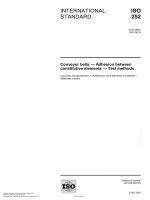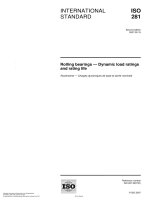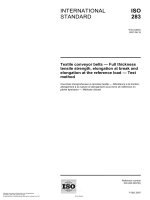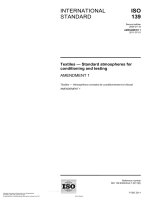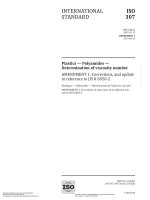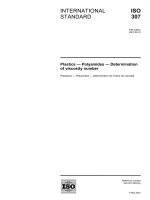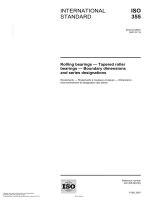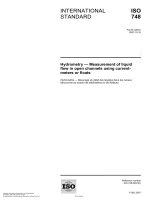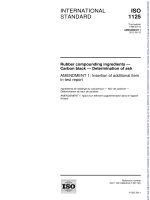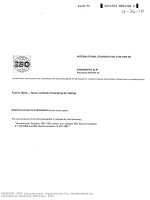Tiêu chuẩn iso 16602 2007 amd1 2012
Bạn đang xem bản rút gọn của tài liệu. Xem và tải ngay bản đầy đủ của tài liệu tại đây (134.68 KB, 10 trang )
INTERNATIONAL
STANDARD
ISO
16602
First edition
2007-12-15
AMENDMENT 1
2012-09-15
Protective clothing for protection against
chemicals — Classification, labelling and
performance requirements —
AMENDMENT 1
Vêtements de protection contre les produits chimiques — Classification,
étiquetage et exigences de performances —
AMENDEMENT 1
Reference number
ISO 16602:2007/Amd.1:2012(E)
--`,,```,,,,````-`-`,,`,,`,`,,`---
Copyright International Organization for Standardization
Provided by IHS under license with ISO
No reproduction or networking permitted without license from IHS
© ISO 2012
Not for Resale
ISO 16602:2007/Amd.1:2012(E)
--`,,```,,,,````-`-`,,`,,`,`,,`---
COPYRIGHT PROTECTED DOCUMENT
©
ISO 2012
All rights reserved. Unless otherwise specified, no part of this publication may be reproduced or utilized in any form or by any means,
electronic or mechanical, including photocopying and microfilm, without permission in writing from either ISO at the address below or ISO’s
member body in the country of the requester.
ISO copyright office
Case postale 56 • CH-1211 Geneva 20
Tel. + 41 22 749 01 11
Fax + 41 22 749 09 47
Web www.iso.org
Published in Switzerland
ii
Copyright International Organization for Standardization
Provided by IHS under license with ISO
No reproduction or networking permitted without license from IHS
© ISO 2012 – All rights reserved
Not for Resale
ISO 16602:2007/Amd.1:2012(E)
Foreword
ISO (the International Organization for Standardization) is a worldwide federation of national standards bodies
(ISO member bodies). The work of preparing International Standards is normally carried out through ISO
technical committees. Each member body interested in a subject for which a technical committee has been
established has the right to be represented on that committee. International organizations, governmental and
non-governmental, in liaison with ISO, also take part in the work. ISO collaborates closely with the International
Electrotechnical Commission (IEC) on all matters of electrotechnical standardization.
International Standards are drafted in accordance with the rules given in the ISO/IEC Directives, Part 2.
The main task of technical committees is to prepare International Standards. Draft International Standards
adopted by the technical committees are circulated to the member bodies for voting. Publication as an
International Standard requires approval by at least 75 % of the member bodies casting a vote.
Attention is drawn to the possibility that some of the elements of this document may be the subject of patent
rights. ISO shall not be held responsible for identifying any or all such patent rights.
Amendment 1 to ISO 16602:2007 was prepared by Technical Committee ISO/TC 94, Personal safety —
Protective clothing and equipment, Subcommittee SC 13, Protective clothing.
--`,,```,,,,````-`-`,,`,,`,`,,`---
iii
© ISO 2012 – All rights reserved
Copyright International Organization for Standardization
Provided by IHS under license with ISO
No reproduction or networking permitted without license from IHS
Not for Resale
--`,,```,,,,````-`-`,,`,,`,`,,`---
Copyright International Organization for Standardization
Provided by IHS under license with ISO
No reproduction or networking permitted without license from IHS
Not for Resale
ISO 16602:2007/Amd.1:2012(E)
Protective clothing for protection against chemicals —
Classification, labelling and performance requirements —
AMENDMENT 1
Page v, Introduction
Add the following after the last paragraph:
Changes introduced by Amendment 1:
—
Experimental work has shown that the test method to assess flammability of chemical protective
clothing materials was not suitable for some materials used for this purpose. Since it was not possible
to reach a good reproducibility of test results, it was decided to remove this test requirement from this
International Standard.
—
The references to ISO 17491:2002 have been replaced by references to four new parts of ISO 17491.
—
Some editorial changes have been made in 5.10, A.1, A.3, G.3 and G.6 in order to achieve a better,
unambiguous understanding of the requirements in these clauses.
—
In 6.5.1 and 6.5.2 the specifications for the reporting of test results has been improved.
—
Errors in 6.6, 6.14, 7.5.2, 7.6.5 and G.6 have been corrected.
Page 2, Normative references
Delete:
EN 13274-4:2001, Respiratory protective devices — Methods of test — Part 4: Flame tests
ISO 17491:2002, Protective clothing — Protection against gaseous and liquid chemicals — Determination
of resistance of protective clothing to penetration by liquids and gases
Add:
ISO 17491-1:2012, Protective clothing — Test methods for clothing providing protection against chemicals —
Part 1: Determination of resistance to outward leakage of gases (internal pressure test)
ISO 17491-2:2012, Protective clothing — Test methods for clothing providing protection against chemicals —
Part 2: Determination of resistance to inward leakage of aerosols and gases (inward leakage test)
ISO 17491-3:2008, Protective clothing — Test methods for clothing providing protection against
chemicals — Part 3: Determination of resistance to penetration by a jet of liquid (jet test)
ISO 17491-4:2008, Protective clothing — Test methods for clothing providing protection against
chemicals — Part 4: Determination of resistance to penetration by a spray of liquid (spray test)
Page 7, 5.4
Leak tightness
--`,,```,,,,````-`-`,,`,,`,`,,`---
Replace the existing subclause with the following:
1
© ISO 2012 – All rights reserved
Copyright International Organization for Standardization
Provided by IHS under license with ISO
No reproduction or networking permitted without license from IHS
Not for Resale
ISO 16602:2007/Amd.1:2012(E)
When tested in accordance with ISO 17491-1:2012, Method 2, Type 1a, Type 1b and Type 1c chemical
protective suits shall not have a pressure drop of more than 20 % after the pressure/inflation period. Leak
tightness testing shall be performed on two chemical protective suits.
Page 7, 5.5
Inward leakage
Replace the existing subclause with the following:
When tested for inward leakage as specified in ISO 17491-2:2012, Method 1 or 2, Type 1c and Type 2
chemical protective suits shall not have an inward leakage greater than 0,05 %. Type 1b chemical protective
suits shall be tested for inward leakage when the facemask is not permanently joined to the suit, and shall
not have an inward leakage greater than 0,05 % in the ocular cavity of the mask. Inward leakage testing
shall be performed on two sample clothing items. A separate test subject shall be used for each test.
Page 7, 5.6
Liquid penetration resistance (jet test)
Replace the existing subclause with the following:
Type 3 chemical protective clothing shall be conditioned by wearing according to Procedure C of Annex A
and, when subsequently tested for liquid penetration resistance using a jet test in accordance with
ISO 17491-3:2008, shall show no penetration greater than three times the total calibrated stain area.
Liquid penetration resistance testing shall be performed on two sample clothing items using a separate
test subject for each test.
Page 7, 5.7
Liquid penetration resistance (spray test)
Replace the existing subclause with the following:
--`,,```,,,,````-`-`,,`,,`,`,,`---
Type 4 chemical protective clothing shall be conditioned by wearing according to Procedure C of Annex A
and, when subsequently tested for liquid penetration resistance using a spray test in accordance with
ISO 17491-4:2008, Method B, shall show no penetration greater than three times the total calibrated
stain area. Liquid penetration resistance testing shall be performed on two sample clothing items using a
separate test subject for each test.
Page 8, 5.9
Limited liquid penetration resistance (modified spray test)
Replace the existing subclause with the following:
Type 6 chemical protective clothing shall be conditioned by wearing according to Procedure C of Annex A
and, when subsequently tested for limited liquid penetration resistance using a modified spray test in
accordance with ISO 17491-4:2008, Method A, using a 1 min exposure, shall show no penetration greater
than three times the total calibrated stain area. Liquid penetration resistance testing shall be performed on
two sample clothing items using a separate test subject for each test.
Page 8, 5.10
Practical performance
Replace the text of list item b) with the following:
During the practical performance test, the test subject shall be asked to read a sign with the dimensions
of 100 mm high and 200 mm wide at a distance of 6 m; on the sign there shall be four randomly selected
letters of proportional font so that they fill the sign. For chemical protective clothing with hoods that are
not at a fixed distance from the wearer’s eyes, the hood/visor shall be worn in the typical wearing position.
2
Copyright International Organization for Standardization
Provided by IHS under license with ISO
No reproduction or networking permitted without license from IHS
© ISO 2012 – All rights reserved
Not for Resale
ISO 16602:2007/Amd.1:2012(E)
Page 9, 5.11
Face piece
Replace the third paragraph with the following:
If the face piece is attached to a Type 1b chemical protective suit in a non-permanent manner, the
sealing mechanism shall be tested for liquid penetration resistance using a jet test in accordance with
ISO 17491-3:2008, and shall show no penetration greater than three times the calibrated stain area. Two
samples of face piece to suit joints shall be tested after temperature conditioning (see 5.2).
Page 13, Table 3
Delete the reference to subclause 6.16 as follows:
Subclause
6.16
Specific requirement
Resistance to flame
Type of chemical protective clothing
X
X
X
X
X
X
—
X
Page 14, 6.5.1 General
Replace the second paragraph with the following:
Materials used in Types 1, 2 and 3 chemical protective clothing shall achieve at least Class 3 performance
against at least one of the chemicals listed in ISO 6529:2001, Annex A. The results shall be reported in
the manufacturer’s product technical information as specified in 10.3, together with a statement indicating
whether the results have been obtained by closed loop testing or open loop testing.
Page 14, 6.5.1 General
Replace the fifth paragraph with the following:
Materials used in Type 4 chemical protective clothing – unless tested and classified according to 6.6 for
resistance to penetration by liquid under pressure – shall achieve at least permeation resistance Class 1
performance against the specific chemicals indicated by the manufacturer. The results shall be reported in
the manufacturer’s product technical information as specified in 10.3, together with a statement indicating
whether the results have been obtained by closed loop testing or open loop testing.
Page 14, 6.5.2 Classification of permeation resistance by breakthrough time (optional)
Replace the first paragraph with the following:
In addition to classifying the permeation resistance of the chemical protective clothing material according
to average time to reach a cumulative permeation of 150 μg/cm2, the option of classifying the material
according to the normalized breakthrough time using a permeation rate of 0,1 μg/cm2min, or the normalized
breakthrough time using a permeation rate of 1,0 μg/cm2min, or both normalized breakthrough times, may
be chosen. The chemical protective clothing material average normalized breakthrough times shall be
classified according to the levels of performance provided in Table 5. The results shall be reported in the
manufacturer’s product technical information as specified in 10.3, together with a statement indicating
whether the results have been obtained by closed loop testing or open loop testing.
--`,,```,,,,````-`-`,,`,,`,`,,`---
3
© ISO 2012 – All rights reserved
Copyright International Organization for Standardization
Provided by IHS under license with ISO
No reproduction or networking permitted without license from IHS
Not for Resale
ISO 16602:2007/Amd.1:2012(E)
Page 15, 6.6
Resistance to penetration by liquid under pressure
In the first line, replace “ISO 13994:2005, Method E” with “ISO 13994:2005, Procedure D”.
Page 19, 6.14
Abrasion resistance
Replace the first paragraph with the following:
When tested in accordance with ISO 12947-2 in the inverted mode, i.e. a test specimen of at least 140mm
diameter placed on the abradant table and an abradant of at least 30mm diameter mounted in the test piece
holder, using abrasive paper specified in Annex F and with an applied pressure of 9 kPa, the chemical
protective clothing material abrasion resistance shall be classified using the number of abrasion cycles
which cause damage to the material according to the levels of performance provided in Table 14. Four
specimens shall be tested and the performance classified according to the lowest single result.
Page 21, 6.16
Resistance to flame
Delete the entire subclause.
Page 23, 7.5.2 Seam strength
Renumber the existing Table 18 as Table 17.
Page 24, 7.6.5 Resistance to ignition
Delete the entire subclause.
Page 27, 10.4
Other test information
Add the following after the first paragraph:
If the garment is flame retardant, this shall be shown by test results obtained with a suitable test method.
If the garment is not claimed to be flame retardant, the product information shall contain the warning:
“Flammable. Keep away from fire.”
NOTE
For example, ISO 14116 specifies the performance requirements for the limited flame spread properties
of materials, material assemblies and protective clothing in order to reduce the possibility of the clothing burning
and thereby itself constituting a hazard. The classification system is based on testing according to ISO 15025:2000.
Previous, less severe minimum requirements for resistance to ignition or resistance to flame of clothing materials,
visors, etc., were based on test results in EN 13274-4, Method 3, which however has been found unsuitable for
assessing flame retardance.
Page 28, A.1
Procedure A
Replace list item d) with the following:
Stand erect with the arms down at the side of the body. Raise extended arms in the lateral direction on
either side of the body upwards until the arms are vertical. Then bend the arms at elbows so that the upper
arm is still vertical while the lower arm is horizontal, with the wrists backwards above the head. Repeat
exercise four times. Then stand again erect with the arms down at the side of the body. Raise extended
arms forward upwards until the arms are vertical. Then bend the arms at the elbows so that the upper
--`,,```,,,,````-`-`,,`,,`,`,,`---
4
Copyright International Organization for Standardization
Provided by IHS under license with ISO
No reproduction or networking permitted without license from IHS
© ISO 2012 – All rights reserved
Not for Resale
ISO 16602:2007/Amd.1:2012(E)
arm is still vertical while the lower arm is horizontal, with the wrists backwards above the head. Repeat
exercise four times.
Page 29, A.3
Procedure C
Replace the seventh bullet with the following:
—
movement 7: kneel as in movement 4, left arm hanging loosely at side; raise left arm fully overhead;
repeat movement with alternate posture by alternating arms.
Page 38, G.3
Test apparatus
Replace the first sentence with the following:
The apparatus with rectangular cross-section shown in Figure G.1 shall typically be used to measure
leakage through the specimen after flex cracking. For damage assessment after abrasion, a similar
apparatus shall be used, but of appropriate round shape and dimensions for holding the test specimen.
Page 39, G.6
Test report
Replace the title of Figure G.1 with the following:
Figure G.1 — Example of apparatus to test for sample damage
after materials testing (rectangular test pot)
Page 40, Bibliography
Add:
ISO 14116, Protective clothing — Protection against heat and flame — Limited flame spread materials,
material assemblies and clothing
ISO 15025, Protective clothing — Protection against heat and flame — Method of test for limited flame spread
--`,,```,,,,````-`-`,,`,,`,`,,`---
EN 13274-4:2001, Respiratory protective devices — Methods of test — Part 4: Flame tests
5
© ISO 2012 – All rights reserved
Copyright International Organization for Standardization
Provided by IHS under license with ISO
No reproduction or networking permitted without license from IHS
Not for Resale
ISO 16602:2007/Amd.1:2012(E)
ICS 13.340.10
Price based on 5 pages
--`,,```,,,,````-`-`,,`,,`,`,,`---
© ISO 2012 – All rights reserved
Copyright International Organization for Standardization
Provided by IHS under license with ISO
No reproduction or networking permitted without license from IHS
Not for Resale
